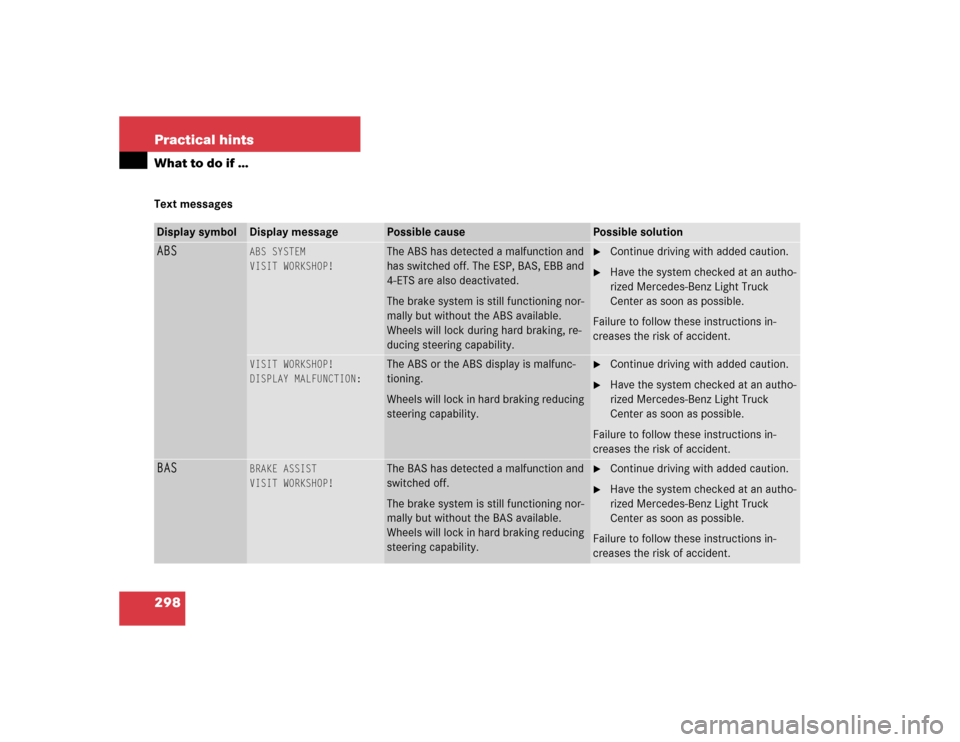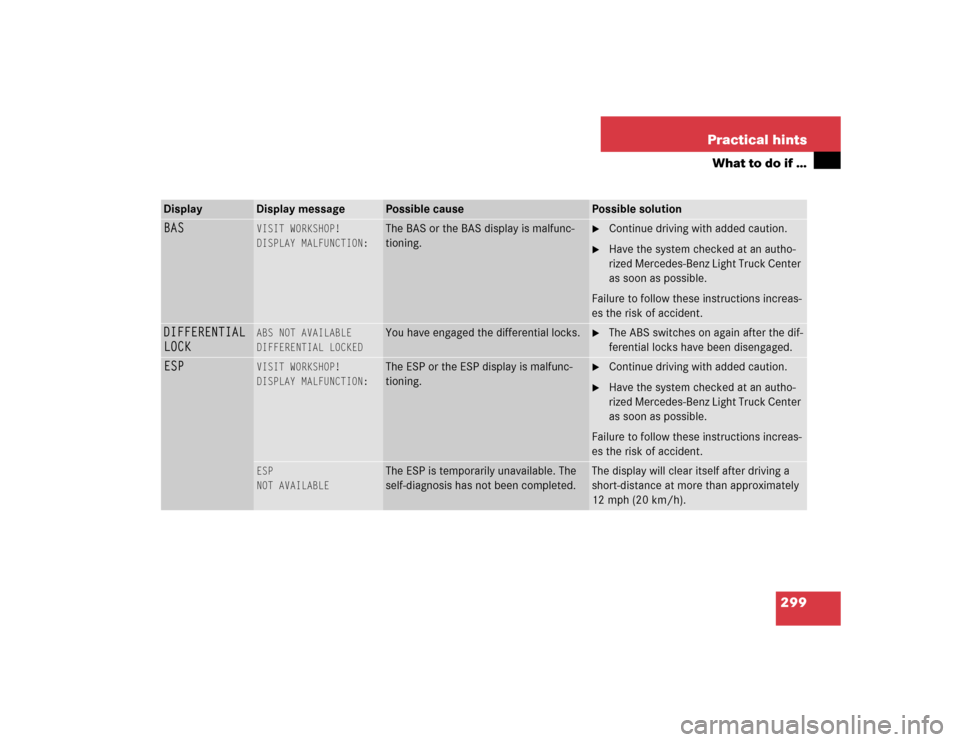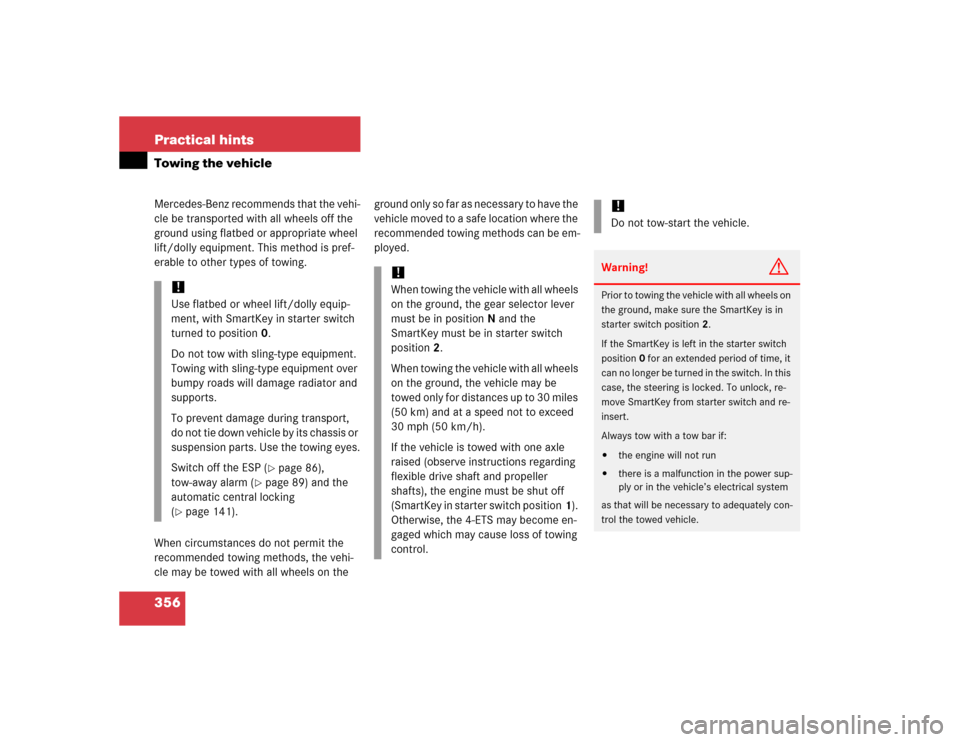Page 298 of 416

298 Practical hintsWhat to do if …Text messagesDisplay symbol
Display message
Possible cause
Possible solution
ABS
ABS SYSTEM
VISIT WORKSHOP!
The ABS has detected a malfunction and
has switched off. The ESP, BAS, EBB and
4-ETS are also deactivated.
The brake system is still functioning nor-
mally but without the ABS available.
Wheels will lock during hard braking, re-
ducing steering capability.
�
Continue driving with added caution.
�
Have the system checked at an autho-
rized Mercedes-Benz Light Truck
Center as soon as possible.
Failure to follow these instructions in-
creases the risk of accident.
VISIT WORKSHOP!
DISPLAY MALFUNCTION:
The ABS or the ABS display is malfunc-
tioning.
Wheels will lock in hard braking reducing
steering capability.
�
Continue driving with added caution.
�
Have the system checked at an autho-
rized Mercedes-Benz Light Truck
Center as soon as possible.
Failure to follow these instructions in-
creases the risk of accident.
BAS
BRAKE ASSIST
VISIT WORKSHOP!
The BAS has detected a malfunction and
switched off.
The brake system is still functioning nor-
mally but without the BAS available.
Wheels will lock in hard braking reducing
steering capability.
�
Continue driving with added caution.
�
Have the system checked at an autho-
rized Mercedes-Benz Light Truck
Center as soon as possible.
Failure to follow these instructions in-
creases the risk of accident.
Page 299 of 416

299 Practical hints
What to do if …
Display
Display message
Possible cause
Possible solution
BAS
VISIT WORKSHOP!
DISPLAY MALFUNCTION:
The BAS or the BAS display is malfunc-
tioning.
�
Continue driving with added caution.
�
Have the system checked at an autho-
rized Mercedes-Benz Light Truck Center
as soon as possible.
Failure to follow these instructions increas-
es the risk of accident.
DIFFERENTIAL
LOCK
ABS NOT AVAILABLE
DIFFERENTIAL LOCKED
You have engaged the differential locks.
�
The ABS switches on again after the dif-
ferential locks have been disengaged.
ESP
VISIT WORKSHOP!
DISPLAY MALFUNCTION:
The ESP or the ESP display is malfunc-
tioning.
�
Continue driving with added caution.
�
Have the system checked at an autho-
rized Mercedes-Benz Light Truck Center
as soon as possible.
Failure to follow these instructions increas-
es the risk of accident.
ESP
NOT AVAILABLE
The ESP is temporarily unavailable. The
self-diagnosis has not been completed.
The display will clear itself after driving a
short-distance at more than approximately
12 mph (20 km/h).
Page 300 of 416

300 Practical hintsWhat to do if …Display
Display message
Possible cause
Possible solution
ESP
ESP
NOT AVAILABLE
The charging voltage has fallen below
10 volts and the ESP has switched off.
�
When the voltage is above this value
again, the ESP is operational again.
�
If necessary, have the generator (alter-
nator) and battery checked.
The ESP is deactivated because of a mal-
function or interrupted power supply. The
ABS and BAS might not be operational.
The system must be resynchronized.
�
Synchronize the ESP. With vehicle sta-
tionary and the engine running, turn
the steering wheel completely to the
left and then to the right to synchro-
nize the ESP.
If the ESP message does not go out:
�
Continue driving with added caution.
�
Visit an authorized Mercedes-Benz
Light Truck Center as soon as possi-
ble.
Failure to follow these instructions in-
creases the risk of accident.
!When synchronizing the ESP, make
sure you can turn the steering wheel in
both directions as far as it will go with-
out the wheels hitting any objects, e.g.
a road curb.
Page 301 of 416
301 Practical hints
What to do if …
Display
Display message
Possible cause
Possible solution
ESP
ESP
VISIT WORKSHOP!
The ESP is switched off due to a malfunc-
tion or an interruption in the power sup-
ply.
The brake system is still functioning nor-
mally but without ESP, ABS and BAS avail-
able.
If in addition the ABS is malfunctioning,
only partial engine output will be avail-
able.
�
Continue driving with added caution.
�
Have the system checked at an autho-
rized Mercedes-Benz Light Truck
Center as soon as possible.
Failure to follow these instructions in-
creases the risk of accident.
Page 342 of 416
342 Practical hintsReplacing bulbs1Securing screw
2Tail lamp lens
3Turn signal lamp bulb
4Tail lamp bulb
5Brake lamp bulb
�
Loosen and remove securing
screws1.
�
Remove tail lamp lens2.
�
Press gently onto respective bulb3,
4, or5 and turn counterclockwise
out of its bulb socket.
�
Press the new bulb gently into its bulb
socket and turn clockwise until it
engages.
�
Reinstall tail lamp lens2.
�
Install and tighten securing screws1.Rear fog lamp/Backup lamp
1Securing screw
2Lamp lens
3BulbiDo not overtighten securing screws1.
Otherwise tail lamp lens2 could be
damaged.
Page 353 of 416
353 Practical hints
Battery
Reconnecting the battery�
Turn off all electrical consumers.
�
Connect the positive lead and fasten its
cover.
�
Connect the negative lead.
�
Install the breather hose.!Never invert the terminal connections.!The battery, its filler caps and the vent
tube must always be securely installed
when the vehicle is in operation.
iThe following procedures must be car-
ried out following any interruption of
battery power (e.g. due to reconnec-
tion):�
Set the clock (see COMAND
operator’s manual).
�
Resynchronize the front seat head
restraints and seat adjustment fore,
aft (
�page 102).
�
Synchronize the ESP (
�page 300).
Page 356 of 416

356 Practical hintsTowing the vehicleMercedes-Benz recommends that the vehi-
cle be transported with all wheels off the
ground using flatbed or appropriate wheel
lift/dolly equipment. This method is pref-
erable to other types of towing.
When circumstances do not permit the
recommended towing methods, the vehi-
cle may be towed with all wheels on the ground only so far as necessary to have the
vehicle moved to a safe location where the
recommended towing methods can be em-
ployed.
!Use flatbed or wheel lift/dolly equip-
ment, with SmartKey in starter switch
turned to position0.
Do not tow with sling-type equipment.
Towing with sling-type equipment over
bumpy roads will damage radiator and
supports.
To prevent damage during transport,
do not tie down vehicle by its chassis or
suspension parts. Use the towing eyes.
Switch off the ESP (
�page 86),
tow-away alarm (
�page 89) and the
automatic central locking
(
�page 141).
!When towing the vehicle with all wheels
on the ground, the gear selector lever
must be in position N and the
SmartKey must be in starter switch
position2.
When towing the vehicle with all wheels
on the ground, the vehicle may be
towed only for distances up to 30 miles
(50 km) and at a speed not to exceed
30 mph (50 km/h).
If the vehicle is towed with one axle
raised (observe instructions regarding
flexible drive shaft and propeller
shafts), the engine must be shut off
(SmartKey in starter switch position1).
Otherwise, the 4-ETS may become en-
gaged which may cause loss of towing
control.
!Do not tow-start the vehicle.Warning!
G
Prior to towing the vehicle with all wheels on
the ground, make sure the SmartKey is in
starter switch position2.
If the SmartKey is left in the starter switch
position0 for an extended period of time, it
can no longer be turned in the switch. In this
case, the steering is locked. To unlock, re-
move SmartKey from starter switch and re-
insert.
Always tow with a tow bar if:�
the engine will not run
�
there is a malfunction in the power sup-
ply or in the vehicle’s electrical system
as that will be necessary to adequately con-
trol the towed vehicle.
Page 359 of 416
359 Practical hints
Towing the vehicle
Front towing eye
In the front, the towing eye is located on
the driver’s side under the bumper.
1Towing eye
Rear towing eye
In the rear, the towing eye is located on the
driver’s side under the bumper.
1Towing eye
Freeing a stranded vehicle
Freeing a stranded vehicle, on which the
wheels are dug into sand or mud, should
be done with the greatest of care, especial-
ly if the vehicle is heavily loaded.
Avoid pulling the vehicle jerkily or diago-
nally, since it could result in damage to the
chassis alignment.
Never try to free a vehicle that is still cou-
pled to a trailer.
If possible, a vehicle equipped with trailer
hitch receiver should be pulled backward
in its own previously made tracks.